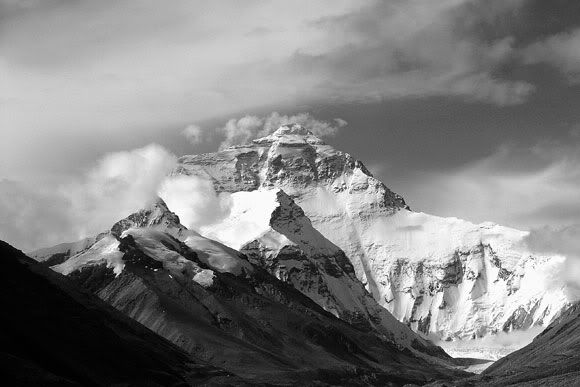
In 2006, a lone climber attempting the summit of Mount Everest for the third time was, purely by chance, caught in an amateur photograph taken by another climber of the scenic mountaintop ahead. The climber in the photograph was making his way up what is known as the Final Push of the Northeast ridge, between Camp VI at 8,230 m and the summit. It was late in the afternoon, a foolishly reckless time to undertake the lengthy and dangerous route.
It would be many hours before the the photographer and his climbing team saw the man again. Leaving the camp at the recommended time, shortly before midnight in order to reach the summit at daybreak, they were first in line of a total of roughly 40 climbers attempting the Final Push that day. A long train of men, all tethered to the lengths of rope permanently in place to keep climbers on the right track.

For decades, this rope had taken climbers within a few feet of what became known as Green Boots cave. A small limestone overhang located at 8500 m, it was already infamous among climbers for the same reason it earned its nickname. For the past ten years, the body of a climber who died in 1996 has been a grim landmark for every climber of the Northeast route, lying curled up in the fetal position, wearing fluorescent green mountaineering boots.
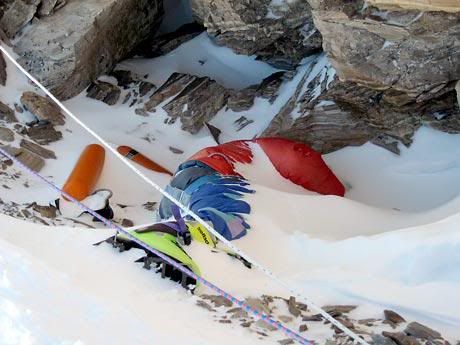
This morning, however, Green Boots had company. Sitting no more than two feet to the left of the corpse was a man who at first glance appeared to be dead. His gloved hands were on his knees, his hood and hat cast his face in shadow. The only feature visible was the man's severely frostbitten nose, already a greenish black hue. On closer inspection, the vapor from the man's breath could be seen rising.
What happened next entered the folklore of the highest mountain on earth. Every man interviewed gives a different story. What is certain is that every single one of the 40-odd climbers attempting the summit that day left the man in the cave, whose name was David Sharp, to freeze, either by choice, by ignorance, or by misjudging him as a corpse they already expected to see in that infamous cave.
While chilling in itself, the incident pales in the bigger context of the deadliness of Mount Everest. For every ten climbers who have ever reached the summit, the mountain has claimed one of them. In the 56 years since the first men in history reached the top, 216 people have died, and the grim reality of the horrific conditions of the Final Push is that 150 bodies have never been, and likely can never be, recovered. They are all still there, and located, almost without exception, in the Death Zone.
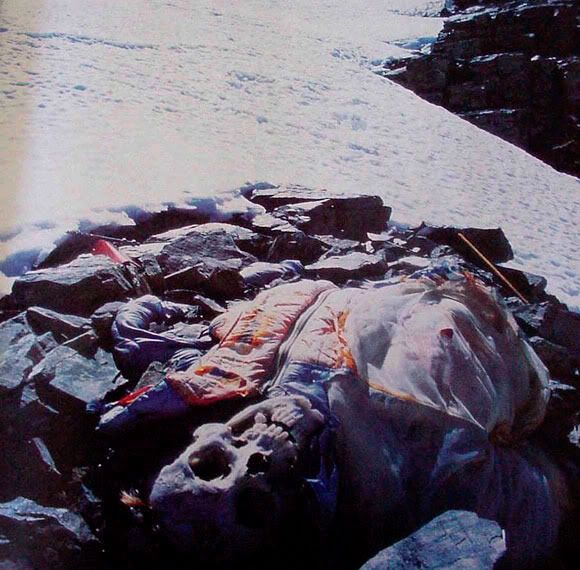
Above a certain altitude, no human can ever acclimatize. Known as the Death Zone, only on 14 mountains worldwide can one step beyond the 8000 meter mark and know that no amount of training or conditioning will ever allow you to spend more than 48 hours there. The oxygen level in the Death Zone is only one third of the sea level value, which in simple terms means the body will use up its store of oxygen faster than breathing can replenish it.
In such conditions, odd things happen to human physical and mental states. A National Geographic climber originally on Everest to document Brian Blessed's (ultimately botched) attempt at summiting, described the unsettling hallucinogenic effects of running out of oxygen in the Death Zone. The insides of his tent seemed to rise above him, taking on cathedral-like dimensions, robbing him of all strength, clouding his judgement. Any stay in the Death Zone without supplementary oxygen is like being slowly choked, all the while having to perform one of the hardest physical feats imaginable.
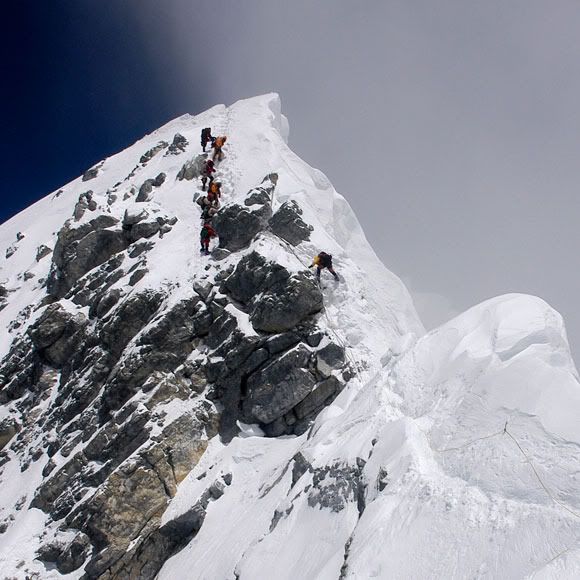
Lack of oxygen and treacherous terrain are not the only challenges on Everest, however. Ascents are very rarely attempted outside a very short window between May and June when conditions are at their absolute best, with average temperatures of -27 degrees celcius, and 50 mph winds. But Mount Everest is so high that the top actually penetrates into the stratosphere, where winds known as Jet Streams can flow up to 200 mph, driving temperatures down to minus 73 degrees celcius.
| Any exposed skin at high altitudes, even at the best of conditions, are prone to frost bite. A reaction to extreme cold, frost bite starts when blood vessels in the skin contract to preserve core body temperature, in conditions where normal blood flow would lead to the body cooling dangerously fast. Over time, if the exposed areas of skin are not heated, the lack of blood flow causes tissue death and, even if reheated, gangrene. At this stage, amputations are common. | 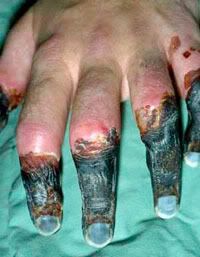 |
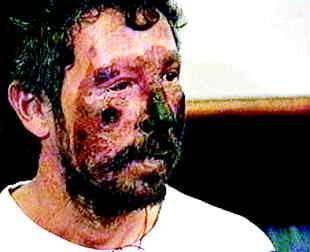 | Climbers are by no means ignorant of these facts. They are reiterated in every source, in every article, and somehow adds to the dangerous allure of the mountain. But in the words of David Brashears, five time summiteer of Everest, "there had been nothing in my training to prepare me to pass through the open graveyard waiting above." |
The case of Hannelore Schmatz is an infamous one. On October 2, 1979, after a successful summit, and for reasons unclear, she died of exhaustion 100 meters short of reaching Camp IV. For years, any climber attempting the southern route could see her body, sitting, leaning against her backpack with her eyes open and brown hair blowing in the wind. Despite being so exposed and so visible along the well-trodden climbing route, rescue operations are virtually suicidal in the Death Zone. A Nepalese police inspector and a Sherpa who tried to recover Hannelore's body in 1984 both fell to their deaths. It was finally high winds that blew her remains over the edge and down the Kangshung face.
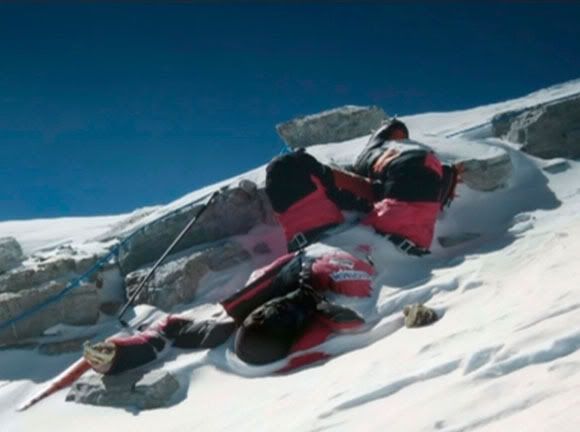
| An area along the northeast route to the summit has earned the unassuming nickname of "Rainbow Valley", simply because of the multicolored down jackets of the numerous corpses littering the hillside. Even in the harsh conditions of lethal altitudes, corpses can remain for decades, some appearing frozen in time with climbing gear intact. Brashears explains, "Despite the snow and ice, Everest is as dry as a desert, the sun and wind quickly mummify human remains." The picture below serves as an example, it shows the corpse of mountaineer George Mallory, lost on Everest in 1924, and the state in which it was found in 1999 after 75 years exposed. | 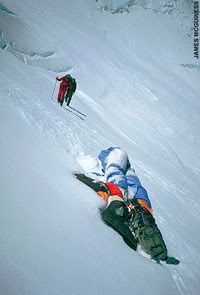 |
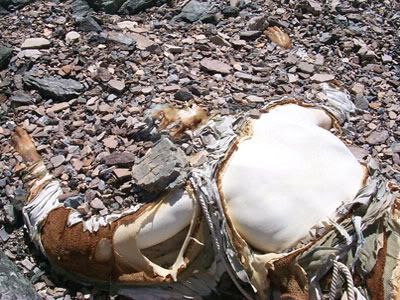
No study has ever been done on the causes of death on Everest, what it is that makes people sit down and give up sometimes within shouting distance of safety. But climbers refer to a kind of confrontation with fear that they experience at a certain point up the mountain. The realization that, not only will you not be able to help anyone else in trouble, but if you mess up, in any way, no one will likely be able to help you either.
Media term it "summit fever", the apparent callousness that drives mountaineers to disregard ethics on their Everest ascents, sometimes literally climbing over dead bodies to reach their goals. But whatever the preparation and outlandish cost, perhaps it's not simply ruthless determination that makes someone abandon their team mates, and yet still have the energy to summit. In such alien conditions, utterly hostile to human life, climbers might face their own mortality. Under the spectre of pure, unadulterated fear, they must realize that they are beyond help as well as beyond helping anyone else.
If they don't, they fall among those who never leave, abandoned on Everest.
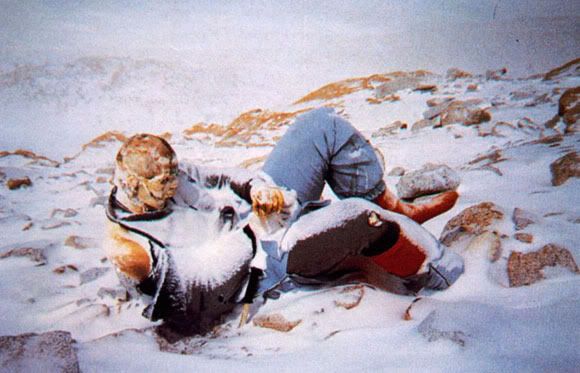
Online Documentaries:
Dark Side of Everest: http://www.youtube.com/watch?v=HQJQapyHAQg
Dying For Everest: http://www.documentary-film.net/search/watch.php?&ref=132
That wasn't Inglis talking about the urge for the tactile when confronted with Sharpe's dying body, it was the climber called Cowboy.
ReplyDeleteEat a dick Max.
ReplyDelete-Ladies everywhere.
To many value of reaching the summit far more than attempting to save a life. They rationalize the behavior but it just doesn't really hold water.
ReplyDeleteThe person in the last photo is Peter Boardman, one of the great british alpinists of the seventies and eighties. He was in his early 30s. That photo was taken on K2, not everest, ten years after he and Joe Tasker disappeared on the west ridge.
ReplyDeleteTo tell the truth, I generally scan online journals on the web. And I like the look and style of your web journal. You can also pay a visit to proof-reading.services. Do you like it?
ReplyDeleteyou have done massive work when collecting this!!
ReplyDeletedress boots for men
Do many of you realize that these climbers were passing him at midnight? It was dark and in many other articles state more about the observations of these climbers- many didn't SEE him during the ascent. It was dark during the time the climbers are supposed to begin the Final Push. They are wearing oxygen masks and heavy coats. Many didn't know he was there or thought he was the famed Green Boots cave occupant. On the way down, many people had attempted to help him. So I plead with you not to pass judgment on people or groups who could either continue their ascent or attempt a rescue of a partly responsive man while faced with the bigger possibility of themselves becoming permanent residents of Green Boots cave alongside its initial victim and its newer one.
ReplyDeleteAll in all, and please raise your to state your claim if I am mistaken, none of us here on this little internet page have summited or attempted to summit Everest. As others have stated, it is a difficult mountain to face- I would call it cruel but everything that happens up there is just a part of the reality of a climber. As far as we know, they enter with a full understanding of the rules. You're a fool to expect help, and a fool to give it. If a climber refuses to acknowledge the reality that will be forced upon them once they began their climb, then they are most likely one of those unfortunate fools who ignorantly entered the "cruel" Death Zone.
Great Share! Thank You! If any disagrees with Oiarzabal then they are not Real climbers. Everest is a shit show nowaday's. It's all about the money! Any person with enough money and a little training can climb Everest now. At least do one thing Everest Climbers, pick up after yourselves! The litter up there is out of control. And you call yourselves nature lovers. If summiting is more important than a human life then you need to take a hard look in the mirror. And if you've left someone to die just so you can summit, I truly hope you can not sleep at night.
ReplyDeleteGreen boots is not rob hall. He's an Indian Mountaineer.
ReplyDeleteGreen boots is neither Scott nor Rob. He's an Indian Mountaineer.
ReplyDeleteGreen boots is not rob hall. He's an Indian Mountaineer.
ReplyDeleteGreat Share! Thank You! If any disagrees with Oiarzabal then they are not Real climbers. Everest is a shit show nowaday's. It's all about the money! Any person with enough money and a little training can climb Everest now. At least do one thing Everest Climbers, pick up after yourselves! The litter up there is out of control. And you call yourselves nature lovers. If summiting is more important than a human life then you need to take a hard look in the mirror. And if you've left someone to die just so you can summit, I truly hope you can not sleep at night.
ReplyDeleteFuck you, sexist asshole. Without women, we wouldn't exist. Women have accomplished great things, so fuck you.
ReplyDeleteFuck you, sexist asshole. Without women, we wouldn't exist. Women have accomplished great things, so fuck you.
ReplyDelete
ReplyDeletedo you want to study in abroad today or in the next intake. we are the best and top rated study abroad consultancies in india with good visa assurance.we usa foreign education consultants in hyderabad
help you in filing the f1 visa for you in very less time. we are also help you with information needed to apply for the college university.
Cool post. All Images are so cute. I like the way you written the post.I like to shop ponchos right now. There are many website who famous for shop ponchos online.
ReplyDeleteThanks for sharing such a nice post.
I Totally agree, You have got to be some sort of Egoist NUTTER! To attempt this utterly pointless & Dangerous pastime.
ReplyDeleteSo for All these Lunatics that have Lost there lives attempting Everest....I Have no Sympathy.
I enjoyed over read your blog post. Your blog have nice information,
ReplyDeleteI got good ideas from this amazing blog.
goldenslot
gclub casino
All these years later, and this is still one of the best blog posts I've ever read. I hope you are still out there somewhere, doing you.
ReplyDeleteThis conflicts with other accounts see The Climb by Boukreev. No one knows who's account is true.
ReplyDeleteAnd you are a stupid ass moron.
ReplyDeleteThe people you mention here didn't deliberately put themselves in that position.. unlike the climbers of Everest.
ReplyDeletegreat post!!
ReplyDeleteor the engine running.
ReplyDeleteyeezy
ReplyDeleteair jordan 1
fear of god hoodie
yeezy
bapesta
kyrie 5 spongebob
yeezys
bape outlet
off white hoodie
air jordan
golden goose outlet
ReplyDeleteoff-white
a bathing ape
paul george
bape hoodie
golden goose outlet
off white hoodie
cheap jordans
kyrie 8 shoes
hermes bag outlet